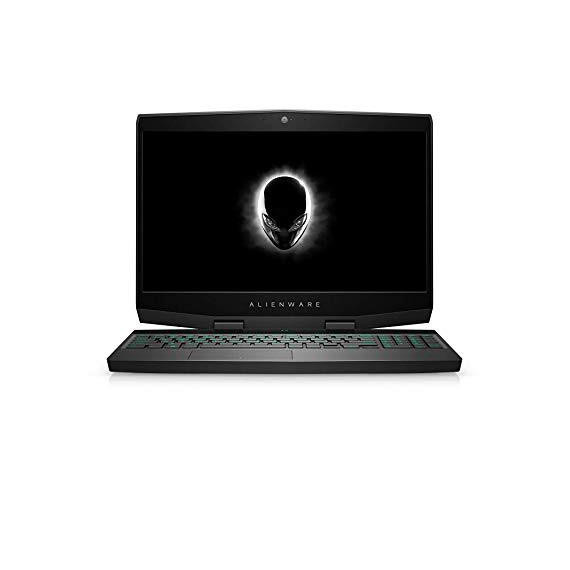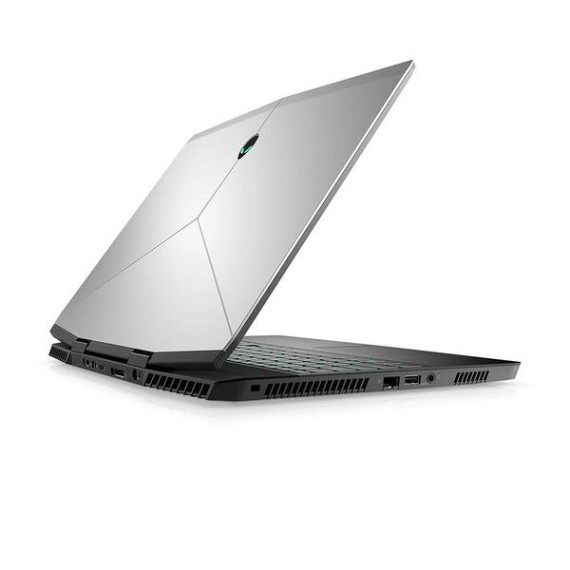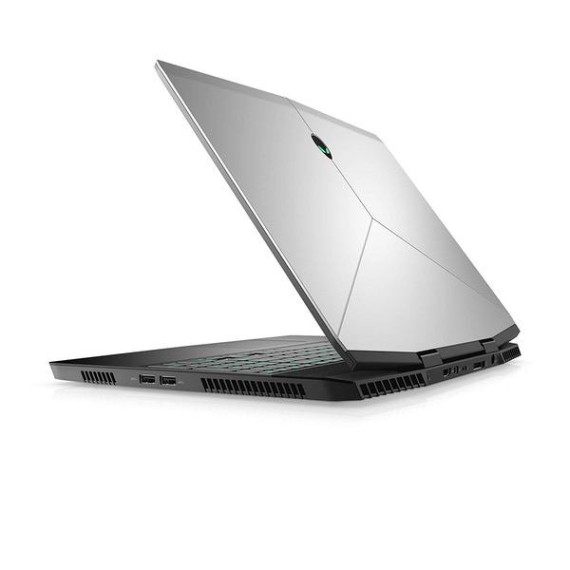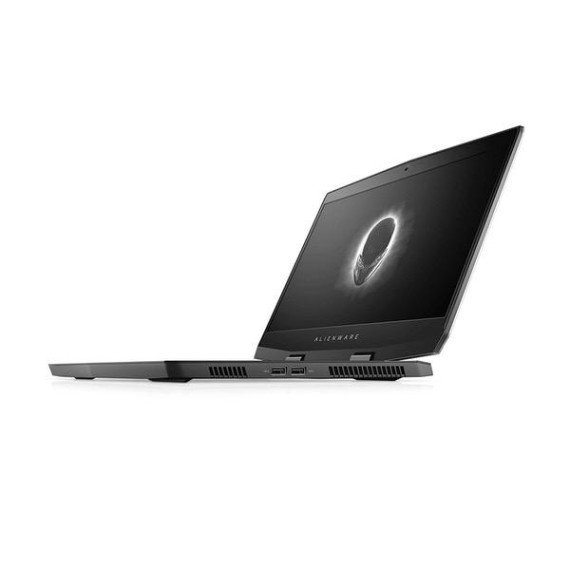Sanpete
The m15 puts the power of Alienware gaming laptops in a smaller package, with a few losses that may not matter much to you. The main differences between the m15 and the current iteration of Alienwares older line of mainstream gaming laptops, the 15 R4 (often just called 15 at the Dell website), are: -- Roughly 1/8" thinner, 1" less wide, 1-1/8" less deep = .96" (with the feet) x 14.3" x 10.8", with much thinner side bezels. -- About 3 lbs lighter = a little under 5 lbs for this configuration. -- Optional new RTX GPU chips, more powerful for ray-tracing graphics. -- Keyboard with 4-zone RGB lighting instead of per-key, brighter backlight, now has (skinny) number pad, half-size cursor keys, chiclet keys with 30% shorter travel. -- Touchpad 35% larger but with no mouse buttons, no longer illuminated. -- Optional 144Hz FHD (1920x1080) screen. -- Optional 240Hz FHD (1920x1080) screen. -- Optional 60Hz UHD (4K) OLED screen. -- No option for G-Sync screen (helps eliminate tearing at cost of battery life--you can still use G-Sync on external screens). -- Two PCIe M.2 slots (for SSDs) plus 2.5" SATA-3 bay (for HDD or SSD), but SATA bay only available with the 60Wh battery (90W also available). 15 R4 has all three slots even with larger battery. -- An additional USB-A 3.1 port (3 total) instead of a dedicated USB-C (now only USB-C is the Thunderbolt 3 port). -- Lighter 180W power supply = 1.6 lbs (15 R4 uses 240W, 1.8 lbs). -- Easier access to internals (no longer have to remove motherboard). -- No illuminated racing stripes on the sides, logo below screen not backlit. The differences between this 1070 GPU configuration and the base (cheapest) configuration of the m15 are: -- GTX 1070 Max Q GPU with 8GB VRAM instead of 1060 with 6GB, for a 25-35% or more increase in graphics performance. -- 16GB RAM instead of 8. -- 128GB SSD in addition to the base 1TB HDD hybrid (with 8GB SSD). According to user reports, if you dont get this with an SSD in one of the M.2 slots you dont get a heat sink for that area either. For a couple weeks there was conflicting information in the description of the 1070 configuration offered here about whether the screen was 144Hz or 60Hz. That seems to have been cleared up: the description only mentions 60 Hz now. You can easily upgrade the RAM, SSD or HDD at home with a screwdriver, and it doesnt affect your warranty. There was supposed to be a base model with an i5 CPU, but that doesnt seem to be currently offered. More features, personal reactions Update April 11: Ill give details at the end of the review for those who want them, but the upshot is that I had to get my battery replaced. It took 7 business days after I shipped the prepaid box to them. (It took about three weeks for the entire process due to delays that most people shouldnt have trouble with.) The repair itself seems to have gone well, and Im back to using my machine as before. This is surprisingly light for such a burly-looking machine, less than a half-pound heavier than my XPS 9570, not hard to carry around. Its solidly put together, no flexing in the base. The lid and its hinges are suitably stiff, dont flop, wiggle or creak when I shake the machine with the screen at a reasonable angle. Dont know if the hinges will loosen up later. I dont do much gaming (though I did some gaming benchmark tests for this review, see below), but the same things that make this a good gaming setup also make it great for other processor-intensive tasks like photo and video editing, VMs and so on. Its significantly more powerful for some professional tasks than most "pro" laptops like the XPS or MacBook Pro. (Whether the appearance is pro depends on what your profession is.) There are a bunch of screen options for this model, of which this configuration has the cheapest. Here are the options from cheapest to most expensive (with the amount extra from base): FHD (1080p) 60Hz FHD 144Hz (+100) FHD 240Hz (+150) UHD (4K) 60Hz (+250) UHD 60Hz OLED (+350) The FHD 60Hz has its advantages for mobile gaming, since it requires the least processing and battery power to operate at its normal settings. The 144Hz and 240Hz options will offer smoother motion, and even though the 4K options will look better for much material, some will still prefer the higher refresh rates for serious gaming. Video editors, on the other hand, may want one of those 4K screens if thats the resolution theyll be working in. According to Notebook Check, the base FHD 60Hz screen has about an average response time (assuming its the same as for the same screen on the 15 R4), measured at 24ms, on the slow side for gaming. Thats about half as fast as the 144Hz option, which is advertised by Dell as 7ms but measured by Notebook Check at 12ms. The screen is anti-glare, which I prefer. Glossy looks nice until theres a glare issue, and then the matte finish saves eye strain and battery life, since you dont have to turn it up as bright to see. I almost always use laptops plugged in, and performance suffers when unplugged anyway (30% or more performance hit), so the small battery isnt a big deal for me. But if you need it, the 60Wh lasts about 4 hours doing light work or web browsing, screen set low (I usually have it at minimum brightness indoors). Takes a little over an hour to recharge to 90%, about 1:25 for a full charge. Thats while still using it. The 90Wh option naturally gives more time, but it fills up the space for the 2.5" SATA 3 bay. Some of the ports are on the back: power, AGA (see below), Thunderbolt 3 (USB-C), Mini-Display Port, and HDMI. Some people prefer back ports, but I find it easier to use side ports in tight spaces and my lap, and theyre easier to get at in general. The Alienware Graphics Amplifier (AGA) port is a proprietary connection for Alienwares proprietary eGPU system (proprietary here meaning you cant use it with non-Alienware computers). Its a few years old now, and it has its quirks, such as not quite fitting some cards and requiring a computer restart when you want to use it, but its still quite capable, more than Thunderbolt 3 eGPU systems, and its fairly cheap. The idea of hooking up a laptop designed for portability to a device roughly 16 x 7 x 6 inches and weighing over 8 pounds with a card is peculiar on its face, but people have their reasons, and if youre one of those people, the port is ready. Since I dont have a desktop, but I do have a 4K TV, I can imagine some use for it someday. The speakers are on the side edges near the front. (The grills above the keyboard must be for cooling.) They benefit from the machine being on a sound-reflective surface. Theyre OK, adequately but not very loud, lacking bass. The headphone jack works fine, and the USB ports have enough juice for my FiiO E10K DAC/amp and moderately demanding Beyerdynamic headphones. This isnt great as a lap laptop unless you have a flat platform to set it on because the main air intake vents are on the bottom. It helps to put something under the back to lift it up a little for better ventilation. I usually use the power cord choke (that little cylinder), which also helps keep cord yanking from damaging the power port. Fan noise isnt too bad. Most of the time I dont hear it, though the left (CPU) fan runs most of the time. When both fans are spinning at 100% its definitely audible but its fairly white noise and not too bothersome unless youre at church or something. The fans dont only spin up in gaming and other intense operations. When I have a dozen tabs open in Firefox, depending on what they are, the fans can also spin up full speed for a few seconds now and then, and sometimes go on for a while at audible levels. That very rarely happens with my 2016 MacBook Pro 15 on which I routinely have 40 or so similar tabs open in Safari with no fan noise. That might be a Firefox or Windows thing, though. The fans dont come on as much when youre operating on battery, no doubt due to the performance limits. The keyboard feels great to me, but Im used to the MBP keyboard, which many people hate. Good travel and feedback, quiet, though the space bar clacks a little. The RGB backlight for the keyboard is very bright. I like it on the lowest of 11 settings that can be controlled with the function keys. I chose white in the color settings, but it retains a slight greenish-blue tint. People in the forums say you cant get it pure white. The light doesnt leak much until you get at a low angle to the keyboard. The keyboard backlight color and numerous other settings including fans and overclocking are controllable, or supposed to be, in the Alienware Command Center program. Its still a work in progress. Ive been able to adjust some things but not others. The program continually calls for the same updates but wont accept them. These are known issues, mostly from before the m15. The surface around the trackpad and below the keyboard has a rubberized feel. It attracts fingerprints (though not as badly as the XPS does). The glossy part above the keyboard shows them even more. A soft cloth removes them. Sleep issue Though theres been less talk about it, the m15 seems to share a sleep issue that has received a fair amount of attention for its Dell sibling XPS 9570. Instead of old-fashioned sleep where the laptop was basically dead to the world until you hit a key or open the lid, these newer Dells use "modern" or "connected" standby, which stays awake enough to receive updates while sleeping. Unfortunately, this kind of sleep also uses more power (1% or more of battery capacity per hour) and the machine sometimes wakes up when you may not want it to, such as when its in a sleeve or backpack. There have been numerous reports of the 9570 being found extremely hot with fans going 100% trying to cool off inside backpacks, though I havent seen any reports of that about the m15, of which there are a lot fewer sold. I have heard my m15 spin up its fans while it was supposedly sleeping, fortunately not in a confined space. If you put your laptop in a backpack or the like, the surest way to prevent this problem is to disable sleep in the settings and use hibernation instead. Hibernation takes longer to wake up, 10-20 seconds, and wont receive updates while asleep, but it uses very little energy and wont wake up unless you make it in the usual ways. Benchmarks and such I ran a bunch of benchmarks so people can more easily compare to other machines. Theyre all free tests you can run on your own machine. I havent altered the processor settings or done a repaste or anything else that would alter performance. These are stock results. In general this machine is fully capable of playing games and doing other processor-intensive tasks at a high level for a laptop. The cooling system is efficient enough to get above-average scores for the processors in some tests. This seems to be (as Notebook Check has suggested) because it handles speed turbo boosting better, despite being smaller than most. The first ones are general performance tests. (PCMark 10s Video score is oddly low, which also pulls down the overall score a little. Ive read that its video test interacts unpredictably with different chip combinations.) Geekbench 4 -- CPU Single-Core: 4948 -- CPU Multi-Core: 21985 -- OpenCL for the 1070 Max Q: 139960 PCMark 10 -- Overall 5338 -- Essentials 8739 -- Productivity 7720 -- Digital Content Creation 6120 -- Apps 11354 -- Chat 7195 -- Web 8171 -- Spreadsheet 10046 -- Writing 5933 -- Photo 8354 -- Rendering 8116 -- Video 3382 Some tests for video and other graphics: Cinebench R15 -- OpenGL 109.92 fps V-Ray -- CPU 1:53 -- GPU 1:28 Octane 4 -- 126.51 Here are some gaming benchmarks. These tests ran the GPU at or near full capacity, 95-100%, but GPU temperatures remained at 70C or below and processor speed remained near 1.5GHz, plus or minus. CPU behavior was sometimes more erratic but still fairly good. For Final Fantasy, with usage mostly between 30 and 50%, higher in a fight scene, the temperature was mostly in the 70s with split-second spikes up to 100C, and processor GHz mostly in the 3s, sometimes dipping to the 2s. The CPU speed didnt seem to correlate with the temperature, but some kind of throttling seems to have been going on. For World of Tanks enCore the CPU was steady at 3.88GHz with about 25% usage. (I didnt get the info for Superposition.) Final Fantasy XV Benchmark -- 1920x1080 High Quality: 6236 The website offers this interpretation of the score: "6000 to 8999. High. You can expect the game to run comfortably. It should run smoothly, even at higher graphics settings." The average reported score for the 1070 Max Q GPU is 5436, the average for 1080 Max Q is 6253. World of Tanks enCore -- 1920x1080 with max settings: 21821 "High performance" Unigine Superposition (2017) -- 1920x1080 High, DirectX: 8001 -- 1920x1080 Extreme, DirectX: 3130 The average frames per second for high quality was 59.84, with minimum 48.6 and maximum 75.23fps. The fps for extreme quality was low, 23.41 average, but it actually looked surprisingly good, with some tearing. Service episode I noticed my touchpad had become hard to use, often a sign of a swollen battery. Sure enough, there was a gap open at the front edge near the touchpad indicating swelling. Hovering over the battery icon showed 33% charge, plugged in but not charging, which isnt normal. I called the Alienware Service number (different from the general Dell number). I had put off my registration to only a couple days before and it hadnt yet taken effect (takes up to a week or so), and there were email problems on their end (they wanted me to send photos while on the call), which together made it a long call, over an hour. The rep suggested I send it in for service, saying it would probably take about 5 business days to get back, though he mentioned 5-8 too. He didnt mention the option of having someone come to my house to fix it, which is something they offer as part of their regular service. When I brought that up, he said they were better equipped to replace the battery at the service center, though he didnt insist it be done that way. Ive read a couple stories of people having trouble getting Dell to come out to replace batteries, with long waits, so I decided to take the reps advice and send it in. He told me a prepaid shipping box would arrive at my door probably the next day. As it turned out, they had trouble registering my machine (probably because its a special case when you get it for review), and their problem receiving my emails persisted, so I didnt actually get a box until 9 business days after I called. Most people wont have either of those issues, and things should go faster. The same rep kept me posted on what was happening throughout. Once I got the box, things went fine. The instructions for packing the machine didnt quite match the padding they sent, but I figured something out, called FedEx the next morning to schedule a pickup, and they picked it up the day after that. I got an email that it had arrived at Dell 3 business days later. I didnt receive any other notices from Dell, but the machine showed up at my door 7 business days after I sent back the box. Altogether it took about three weeks due to the unusual delays, but again most people wont have those issues. The repair itself seems to have been well done. The battery works as expected. The trackpad is back to normal. I havent found any scratches or even fingerprints. There were no issues with data loss or the like.


















